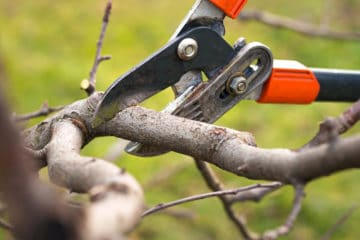

 Do not leave stumps, but do not cut too close to the bud point or to the branch collar and branch ridge. Also during that time period, we have almost no insects out to possibly damage and infest our trees. The trees are still dormant in our area at that time of the year, and since the temperatures are still cold, we normally have a lower incidence of diseases in the environment that can infect our fruit tree since the pruning cuts are entry ways for diseases to enter the tree. While this time frame is best for the tree, it also helps us as there is less snow to have to stand in while pruning. The best time to prune is during late February through the entire month of March. As a general rule, pruning in late winter to early spring is the best time frame. Hazel/Filbert (Corylus)- Multi-trunk with 5-9 trunks. At this point, make sure branches have a good angle of 45-60˚. Make sure branching is pruned off until the central leader is at least 5’ tall. At this point, make sure branches have a good angle of 45-60˚.Ĭhestnut (Castenea)- Central leader. Remove smaller trunks and excess growth throughout the season allowing for 10-12 main trunks. Continue to work the top to keep the tree shorter.įig (Ficus)- In spring, after bud break (late April), remove branches that have died this may mean down to the ground. Persimmon (Diospyros)- Modified central leader. The tree has a central leader, spread laterals to help with sunlight. Pawpaw (Asimina)- Minimal pruning needed. Minimal pruning except to limit the height or crossing limbs.Īpricot (Prunus Armeniaca)- Open-center or modified central leader. Jujube (Zizyphus)- Train as multi-trunk branching at 3-4’ off the ground. Remove stems that are 4-6 years old 1-2" above ground level, as they are less productive. This increases light and air circulation to the interior of the plant. Head leader to create side-branching.Ĭherry, Bush (Prunus x kerrasis)- Use thinning cuts for a less bushy effect. Thin fruit to 8” apart.Ĭherry, Tart (Prunus Cerasus)- Open-center or modified central leader.Ĭherry, Sweet (Prunus Avium)- Modified central leader. Proper fruit twigs are 12-18” and pencil-thin. Thin out twigs under 12”, and crowding twigs. Peach (Prunus Persica)- Last to prune in the dormant season. After 5 years, fruit buds tend to produce inferior fruit, and new laterals are encouraged to take the place of older wood.
Do not leave stumps, but do not cut too close to the bud point or to the branch collar and branch ridge. Also during that time period, we have almost no insects out to possibly damage and infest our trees. The trees are still dormant in our area at that time of the year, and since the temperatures are still cold, we normally have a lower incidence of diseases in the environment that can infect our fruit tree since the pruning cuts are entry ways for diseases to enter the tree. While this time frame is best for the tree, it also helps us as there is less snow to have to stand in while pruning. The best time to prune is during late February through the entire month of March. As a general rule, pruning in late winter to early spring is the best time frame. Hazel/Filbert (Corylus)- Multi-trunk with 5-9 trunks. At this point, make sure branches have a good angle of 45-60˚. Make sure branching is pruned off until the central leader is at least 5’ tall. At this point, make sure branches have a good angle of 45-60˚.Ĭhestnut (Castenea)- Central leader. Remove smaller trunks and excess growth throughout the season allowing for 10-12 main trunks. Continue to work the top to keep the tree shorter.įig (Ficus)- In spring, after bud break (late April), remove branches that have died this may mean down to the ground. Persimmon (Diospyros)- Modified central leader. The tree has a central leader, spread laterals to help with sunlight. Pawpaw (Asimina)- Minimal pruning needed. Minimal pruning except to limit the height or crossing limbs.Īpricot (Prunus Armeniaca)- Open-center or modified central leader. Jujube (Zizyphus)- Train as multi-trunk branching at 3-4’ off the ground. Remove stems that are 4-6 years old 1-2" above ground level, as they are less productive. This increases light and air circulation to the interior of the plant. Head leader to create side-branching.Ĭherry, Bush (Prunus x kerrasis)- Use thinning cuts for a less bushy effect. Thin fruit to 8” apart.Ĭherry, Tart (Prunus Cerasus)- Open-center or modified central leader.Ĭherry, Sweet (Prunus Avium)- Modified central leader. Proper fruit twigs are 12-18” and pencil-thin. Thin out twigs under 12”, and crowding twigs. Peach (Prunus Persica)- Last to prune in the dormant season. After 5 years, fruit buds tend to produce inferior fruit, and new laterals are encouraged to take the place of older wood. 
Thin fruit to 5” apart.Īsian Pear (Pyrus)- Central leader or modified central. Lateral branches are equally spaced around the trunk with 6-8” between. Pear (Pyrus)- Central leader or modified central leader. Work on scaffolds (tiers) Spreading/bending branches is recommended. Apple (Malus)- Preferred form depends on variety, but modified central to central leader works for most.







 0 kommentar(er)
0 kommentar(er)
